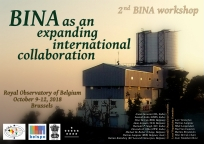Speaker
Dr
Kaushal Sharma
(Inter University Centre for Astronomy and Astrophysics)
Description
We propose an automated approach for the classification of stellar spectra using Deep Neural Networks. Due to the ever-expanding volume of observed spectroscopic data from surveys such as SDSS and LAMOST, it has become important to apply artificial intelligence (AI) techniques for analysing stellar spectra to solve spectral classification and regression problems like the determination of stellar atmospheric parameters Teff, log g and [Fe/H]. Traditional machine learning methods with "shallow" architecture (usually up to 2 hidden layers) have been trained for these purposes in the past. However, deep learning methods with a larger number of hidden layers allow the use of finer details in the spectrum which results in improved accuracy and better generalisation. Studying finer spectral signatures also enables us to find rare objects and outliers. Moreover, such models trained on empirical libraries provide wider coverage of the parameters space as compared to synthetic libraries. We examine various machine and deep learning algorithms like Artificial Neural Networks (ANN), Convolutional Neural Networks (CNN), and Autoencoders to classify stellar spectra using the Jacoby Atlas, and ELODIE and MILES spectral libraries as training samples. We test the performance of the trained networks on the Indo-U.S. Library of Coudé Feed Stellar Spectra (CFLIB). We show that using autoencoders, we are able to achieve a precision of 1.5 spectral sub-classes in the classification scheme as compared to the precision of up to 2 sub-classes achieved in the past studies. The trained model can further be used to classify stellar spectra from large databases (e.g SDSS) with better precision and could also be implemented in data-analysis pipelines for various survey programs. With the latest GAIA release, we also plan to take advantage of distances from this mission to compile a better training sample.
Primary author
Dr
Kaushal Sharma
(Inter University Centre for Astronomy and Astrophysics)
Co-authors
Prof.
Ajit Kembhavi
(Inter University Centre for Astronomy & Astrophysics)
Dr
Aniruddha Kembhavi
(Allen Institute for Artificial Intelligence)
Dr
Sheelu Abraham
(Inter University Centre for Astronomy and Astrophysics)
Dr
Thirupathi Sivarani
(Indian Institute of Astrophysics (IIA))

